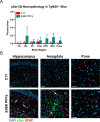The E46K mutation modulates α-synuclein prion replication in transgenic mice
- PMID: 36454879
- PMCID: PMC9714912
- DOI: 10.1371/journal.ppat.1010956
The E46K mutation modulates α-synuclein prion replication in transgenic mice
Abstract
In multiple system atrophy (MSA), the α-synuclein protein misfolds into a self-templating prion conformation that spreads throughout the brain, leading to progressive neurodegeneration. While the E46K mutation in α-synuclein causes familial Parkinson's disease (PD), we previously discovered that this mutation blocks in vitro propagation of MSA prions. Recent studies by others indicate that α-synuclein adopts a misfolded conformation in MSA in which a Greek key motif is stabilized by an intramolecular salt bridge between residues E46 and K80. Hypothesizing that the E46K mutation impedes salt bridge formation and, therefore, exerts a selective pressure that can modulate α-synuclein strain propagation, we asked whether three distinct α-synuclein prion strains could propagate in TgM47+/- mice, which express human α-synuclein with the E46K mutation. Following intracranial injection of these strains, TgM47+/- mice were resistant to MSA prion transmission, whereas recombinant E46K preformed fibrils (PFFs) transmitted neurological disease to mice and induced the formation of phosphorylated α-synuclein neuropathology. In contrast, heterotypic seeding following wild-type (WT) PFF-inoculation resulted in preclinical α-synuclein prion propagation. Moreover, when we inoculated TgM20+/- mice, which express WT human α-synuclein, with E46K PFFs, we observed delayed transmission kinetics with an incomplete attack rate. These findings suggest that the E46K mutation constrains the number of α-synuclein prion conformations that can propagate in TgM47+/- mice, expanding our understanding of the selective pressures that impact α-synuclein prion replication.
Copyright: © 2022 Holec et al. This is an open access article distributed under the terms of the Creative Commons Attribution License, which permits unrestricted use, distribution, and reproduction in any medium, provided the original author and source are credited.
Conflict of interest statement
The authors have declared that no competing interests exist.
Figures






Similar articles
-
Multiple system atrophy prions transmit neurological disease to mice expressing wild-type human α-synuclein.Acta Neuropathol. 2022 Oct;144(4):677-690. doi: 10.1007/s00401-022-02476-7. Epub 2022 Aug 26. Acta Neuropathol. 2022. PMID: 36018376 Free PMC article.
-
Familial Parkinson's point mutation abolishes multiple system atrophy prion replication.Proc Natl Acad Sci U S A. 2018 Jan 9;115(2):409-414. doi: 10.1073/pnas.1719369115. Epub 2017 Dec 26. Proc Natl Acad Sci U S A. 2018. PMID: 29279394 Free PMC article.
-
Multiple system atrophy prions retain strain specificity after serial propagation in two different Tg(SNCA*A53T) mouse lines.Acta Neuropathol. 2019 Mar;137(3):437-454. doi: 10.1007/s00401-019-01959-4. Epub 2019 Jan 28. Acta Neuropathol. 2019. PMID: 30690664 Free PMC article.
-
Is Multiple System Atrophy a Prion-like Disorder?Int J Mol Sci. 2021 Sep 18;22(18):10093. doi: 10.3390/ijms221810093. Int J Mol Sci. 2021. PMID: 34576255 Free PMC article. Review.
-
α-Synuclein: Multiple System Atrophy Prions.Cold Spring Harb Perspect Med. 2018 Jul 2;8(7):a024588. doi: 10.1101/cshperspect.a024588. Cold Spring Harb Perspect Med. 2018. PMID: 28213437 Free PMC article. Review.
Cited by
-
Evidence of a novel α-synuclein strain isolated from a Parkinson's disease with dementia patient sample.Acta Neuropathol Commun. 2025 Aug 18;13(1):177. doi: 10.1186/s40478-025-02093-x. Acta Neuropathol Commun. 2025. PMID: 40826134 Free PMC article.
-
The role of α-synuclein prion strains in Parkinson's disease and multiple system atrophy.PLoS Pathog. 2024 Jan 25;20(1):e1011920. doi: 10.1371/journal.ppat.1011920. eCollection 2024 Jan. PLoS Pathog. 2024. PMID: 38271292 Free PMC article. No abstract available.
-
Structurally targeted mutagenesis identifies key residues supporting -synuclein misfolding in multiple system atrophy.bioRxiv [Preprint]. 2024 Jul 8:2024.07.04.602104. doi: 10.1101/2024.07.04.602104. bioRxiv. 2024. Update in: J Parkinsons Dis. 2024 Nov;14(8):1543-1558. doi: 10.3233/JPD-240296. PMID: 39026799 Free PMC article. Updated. Preprint.
-
Structurally targeted mutagenesis identifies key residues supporting α-synuclein misfolding in multiple system atrophy.J Parkinsons Dis. 2024 Nov;14(8):1543-1558. doi: 10.3233/JPD-240296. Epub 2024 Oct 17. J Parkinsons Dis. 2024. PMID: 39957201 Free PMC article.
-
Role of the Intestinal Microbiota in the Molecular Pathogenesis of Atypical Parkinsonian Syndromes.Int J Mol Sci. 2025 Apr 22;26(9):3928. doi: 10.3390/ijms26093928. Int J Mol Sci. 2025. PMID: 40362171 Free PMC article. Review.
References
-
- Spillantini MG, Schmidt ML, Lee VM-Y, Trojanowski JQ, Jakes R, Goedert M. α-Synuclein in Lewy bodies. Nature. 1997;388:839–40. - PubMed
-
- Polymeropoulos MH, Lavedan C, Leroy E, Ide SE, Dehejia A, Dutra A, et al.. Mutation in the α-synuclein gene identified in families with Parkinson’s disease. Science. 1997;276:2045–7. - PubMed
Publication types
MeSH terms
Substances
Grants and funding
LinkOut - more resources
Full Text Sources
Molecular Biology Databases

